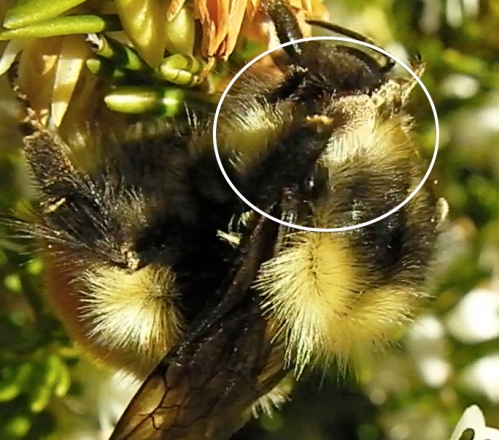- January 14, 2013…a beautiful warm day brought the bees out to the heather. I saw very few honeybees, but very many bombus Melanopygus (this one) and also Bombus vosnesenskii (yellow-faced bumbles)

As she grooms herself with her front legs, you can see what looks to be a static electricity charge on her bee fuzz…it shows up better on the video.
This short video shows a bumblebee (bombus Melanopygus) sipping nectar from heather in mid January. As she sips, pollen can be seen shooting out. Later she grooms herself. I noticed what looked to be a static electricity charge when her front legs combed her fuzzy head.
I didn’t want to interrupt the music so I added some video of my Bee-atrice log hive which didn’t make it through the sub freezing weather. I looked at a comb which had some capped honey as well as uncapped cells. I replaced the comb in the hopes that this hive will attract a swarm in spring.
It should be raining sideways this month. It’s not. After our cold snap, we’ve been enjoying daytime temperatures in the 50’s and 60’s F. (10’s and 20’s C) When I filmed this it was 71 F. (22 C). Our honeybees love it. They are bringing back yellow and orange pollen. I can’t figure where they’re getting it because the pussy willows aren’t blooming yet, but traffic is heavy as can bee seen on the video.
This is my second winter with bees. They don’t fly when it’s raining of course, but we do get breaks in the rain, the sun pops out and the bees are flying. I feel bad for the beekeepers that must tuck their charges to bed in the autumn and trust they will emerge when the weather warms up sometimes months later. I’m talking about people like Emily Heath among others in cold far away places. 🙂 I guess you could say I’m spoiled to be able to see them active during the winter. I don’t know what will happen in spring. It’s possible we’ll get our rain then…given the choice, I’d rather get it now. In any case the bees are making use of the warm weather.
How are your bees?


